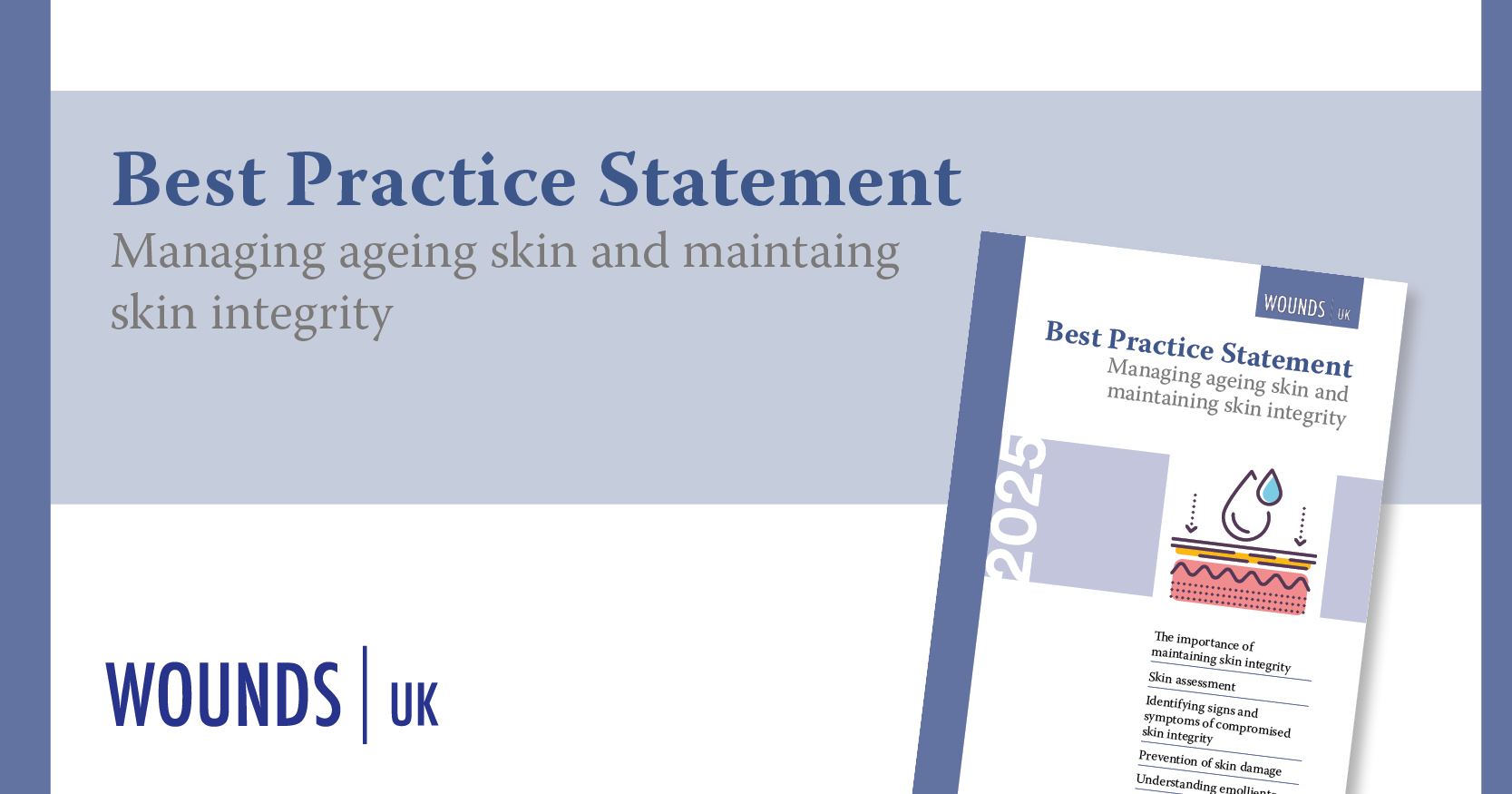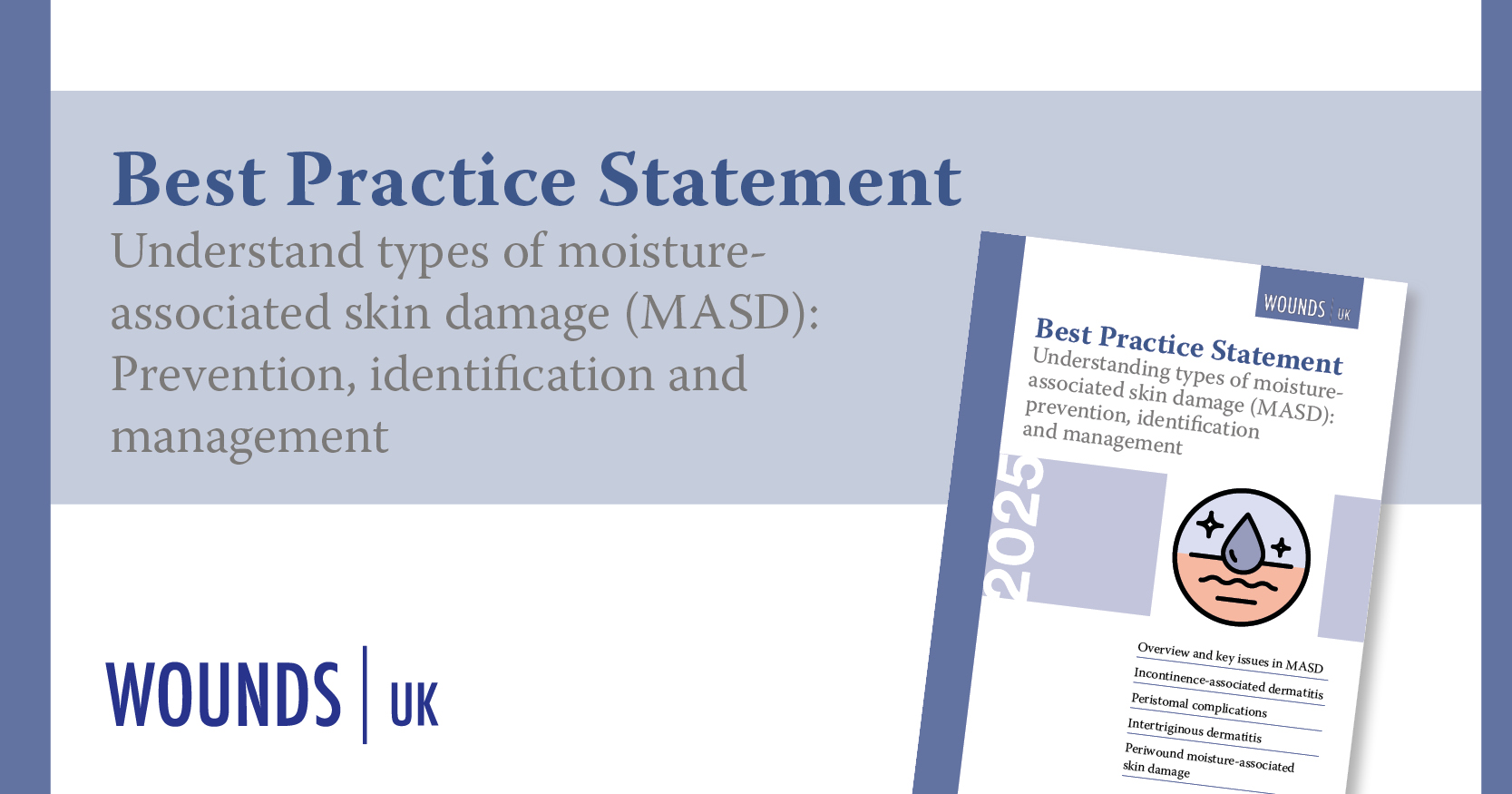What is healthy skin?
The skin is the body’s largest organ. It provides a chemical, physical and mechanical barrier, protecting the body from the external environment, and forming an important part of the innate immune system (see Figure 1; Wounds UK, 2018). Loss of these critical functions in impaired skin compromises immunity, adversely effects the process of homeostasis and reduces the ability to withstand a range of external insults (Moncrieff et al, 2015).
Skin integrity in the diabetic foot
Diabetes is a long-term condition that affects skin integrity (Okano et al, 2016). Autonomic neuropathy is a complication of diabetes that can have a significant impact on skin integrity.
Although the underlying mechanism of skin disorders in diabetes has not been fully elucidated, it has been proposed that increased levels of blood sugar causes impairment to the nerves and blood vessels in the periphery (McGeorge and Walton, 2014). Peripheral arterial disease affects 1 in 3 people with diabetes over the age of 50 and can also increase the risk of heart attack and stroke (National Institute for Health and Care Excellence [NICE], 2019; Okano et al, 2016). The risk of skin problems in people with diabetes is further compounded by an impaired immune system, which leaves patients prone to infections, such as in patients with foot ulcers (Okano et al, 2016).
Impact of skin impairment in diabetes
About 6% of all individuals with diabetes experience diabetic foot complications (Mishra et al, 2017), which is the largest single cause of hospital admission in people with diabetes in the UK (Boulton et al, 2005; National Health Service [NHS] NWCSN, 2017), with the associated social costs estimated at £13.9 billion (Wounds UK, 2019). As well as diabetes-related foot disease and dry, cracked skin, several other skin problems are also associated with diabetes, such as diabetic dermopathy and bullosis diabeticorum, and this highlights the importance of making skin care a priority in diabetes (Diabetes.co.uk, 2023).
Need for structured preventative care and screening assessment
It is well established that diabetes can increase the risk of skin impairment. The skin is a key component of the innate immune system, protecting the body from infection. Diabetes also directly impairs immune function in other ways. Unmanaged skin impairment can increase the risk of infection. For people with diabetes, foot infections can result in serious complications associated with increased morbidity and mortality. While the primary intervention for people with diabetes is to effectively control blood glucose with the aim to reduce the micro and macrovascular complications of the condition, there is an important complementary role for structured preventative care focussed on healthy feet and skin.
Approximately 10% of all people with diabetes will develop a foot ulcer (NICE, 2019), and the impact is huge, resulting in a diminished quality of life and often an inability to work (SWG, 2019). About half of all patients die within 5 years of developing a diabetic foot ulcer and only around 30% of patients survive 5 years after limb amputation (NICE, 2019).
With approximately 7,000 diabetes-related amputations per year in the UK, NICE estimates that diabetes-related foot care costs >£1 billion per year in England alone, with much of this expenditure going towards treating prolonged and severe ulceration (Kerr et al, 2019). Therefore, structured preventive care is critical in tackling this huge problem and development of a trained workforce is an integral part of this prevention strategy.
What does structured preventative care look like?
Structured preventative care involves assessing the individual patient for their level of risk of developing diabetic foot complications and implementing an appropriate plan of care to support the health of the patient’s skin, thereby reducing the risk of future complications (Scharper et al, 2023).
NICE recommends a care blueprint based on diligent risk assessment and patient stratification to (NICE, 2019; Chao and Spry, 2018):
- Assess the risk of developing a diabetic foot problem
- Provide care across all care settings via a dedicated foot protection service for both preventing and managing diabetic foot problems.
Foot care regimen for the patient who has not experienced ulceration
For this patient group, the goal is to prevent diabetes-related wound/ulceration through effective glycaemic control, routine foot health reviews, patient education, and early referrals for pre-ulcerative lesions (Mishra et al, 2017).
NHS strategy for screening and risk-stratifying patients who are at low risk of ulcer provides an action plan that advises clinicians to (NHS NWCSN, 2017; Morey-Vargas and Smith, 2015):
- Educate patients on risk factors and ensure patient understanding on avoiding injuries, inspecting feet daily, following foot hygiene, and selecting appropriate socks and well-fitted footwear
- Ensure routine healthcare assessment and educate patients on seeking immediate help for pain; loss of sensation or cramping in leg areas; change in shape/colour/temperature of foot skin; a blister/sore/ulcer/infected corn/ingrown toenail. Thick/yellow toenails and signs of fungal infection may not be seen as requiring immediate help.
Early intervention aimed at preventing foot complications costs about 10 times less than post-complication intervention, and prevention can lead to much better patient outcomes (Bus and Netten, 2016). Even among people who are at low risk (those without neuropathy or peripheral arterial disease), emphasising prevention should be seen as the foremost ‘strategy’ for addressing diabetic foot complications. This involves the establishment of early habits and routines for regular foot examinations.
For low-risk patients (with no neuropathy or peripheral arterial disease), prevention should be considered the go-to ‘therapy’ to prevent diabetic foot complications, by establishing early routines and patterns of foot checking.
The Capability Framework
Adopting a standardised, structured framework can provide healthcare professionals and multidisciplinary teams with the tools and guidance required for the management and preventive skin care of all individuals with diabetes in line with NICE recommendations.
The Capability Framework for Integrated Diabetic Lower Limb Care: A User’s Guide was developed specifically to provide this structured framework, to support the consistent delivery of care for this patient group.
First developed by TRIEPodD-UK in 2012, the Capability Framework acts as a UK-wide benchmarking tool that healthcare professionals in multidisciplinary diabetes care can use to assess their existing capabilities and identify areas of improvement. This tool also facilitates performance review planning and can help healthcare professionals find the direction they need to become diabetic foot care specialists (SWG, 2019).
The Capability Framework outlines the capabilities that are required for healthcare team members at each level of diabetes care (SWG, 2019). This aims to support the development of a healthcare workforce with the right skills to be able to effectively provide care to people with diabetic foot conditions.
The Capability Framework also provides a useful reference point and benchmark against which healthcare professionals can assess and update their skills and knowledge in managing diabetic foot disease.
Whose responsibility is foot care?
Diabetes foot care requires all healthcare professionals to work towards a shared goal, which can include the support workforce, medics, surgeons (including podiatric surgeons), pharmacists, podiatrists, orthotists and nursing teams (Diabetes on the Net, 2023).
All healthcare professionals caring for people with, or at risk of developing, diabetes-related foot complications should have the core skills and capabilities to either screen or assess the patient’s risk and needs. The Capability Framework provides guidance on how healthcare professionals can effectively carry out screening, assessment, and ongoing care as per their own level within the care pathway.
Preserving skin integrity: practical prevention
It is crucial that people living with diabetes know the importance of routinely checking their feet, even if there are no obvious symptoms affecting their skin. This may include asking a family member or carer to check them if they are unable to. They should be supported to understand how important it is to manage their diabetes to prevent skin complications and development of foot ulceration, and to speak to their healthcare professional as soon as they notice an unhealed cut/blister (Centres for Disease Control and Prevention [CDC], 2023).
Practical tips for foot care
Alongside routine examination, people living with diabetes should also be supported with education on the diabetes-related risk factors that can exacerbate skin/foot problems, such as nerve damage and loss of pain sensation (CDC, 2023).
To keep their feet healthy, there are practical daily tips that people living with diabetes should follow (CDC, 2023):
- Diabetes symptoms and glucose levels: Take medication regularly and on time, as prescribed for you
- Daily foot health check: Check skin or nails for any cuts, spots, calluses, blisters, redness, corns or any other changes. Remember to check the bottom of your feet thoroughly
- Daily foot wash: Wash feet daily with warm water, without soaking them. Dry thoroughly, including between the toes. Apply emollient to the feet daily, but avoid between the toes as this can lead to infection
- Covering feet: In the presence of risk factors, always wear shoes with socks, indoors or outdoors
- Well-fitted footwear: Ensure footwear fits properly and has enough room to accommodate any changes in foot shape. It is helpful to buy shoes in the afternoon as they can swell throughout the day. Break in new footwear gently
- Nail health: Keep nails trimmed and filed
- No self-removal of calluses or corns: Seek clinician’s advice for these and do not use over-the-counter products.
- Blood flow to the toes: Move toes up and down for a few minutes when sitting; repeat several times every day
- Stay active: Routine excercise will improve overall health, and keep the blood circulating.
Creams for diabetic foot — the impact of emollients
Moisturising creams, such as emollients, improve the skin barrier function and relieve the symptoms of impaired skin function. They are an essential part of a skin care regimen in people with fragile or aged skin, and in people at increased risk of skin wounds (Wounds UK, 2018; LeBlanc et al, 2018; Cowdell et al, 2023).
Urea-based emollients for diabetic foot care
Experts consider urea-based emollients more effective moisturisers than non-urea-based emollients in people with diabetes (Bowen et al, 2021), and they strongly recommend accessible patient education on the effective use of urea-based emollients in diabetes-related foot complications (Bowen et al, 2021).
Dry skin loses up to 50% of its urea content, which is why it is important to select urea-based emollients with the right urea content for each patient. Formulations with ≤10% urea are used for moisturising dry skin. Increasing urea concentration beyond >10% has an emollient/keratolytic effect where urea also helps other drug molecules cross skin barriers and is used as a combination therapy (Celleno, 2018).
Importance of footwear and use of insoles
Pressure on feet is a known external cause of diabetic foot ulcers (Tang et al, 2023), which is exacerbated by ill-fitting footwear (Chang et al, 2022). Recurrent foot ulcers are more common in patients who do not wear suitable protective footwear. Ideal footwear should reduce the pressure on feet by at least 30% (Chang et al, 2022):
- All healthcare professionals within multidisciplinary teams should understand and educate patients on the importance of well-fitting footwear and the impact of insoles on load distribution, load sharing and acute diabetic foot complications (SWG, 2019)
- A referral to an orthotist or footwear specialist should be considered for orthopaedic footwear with insoles to redistribute pressure and accommodate deformity (Chang et al, 2022)
- Wearing custom-made, non-rigid insoles can help redistribute the pressure by serving as the backbone of shoes
- In people with no existing diabetic foot disease, appropriate footwear paired with a simple pressure-relieving insole can be sufficient as part of preventative care to halt or offset the risk of diabetes foot.
Product selection, key components and tips for use
Choosing the right products for moisturising and supporting feet is a key decision in long term foot care, especially for people with diabetes. Essentially, patient choice should be the first step in emollient selection (Moncreiff et al, 2013), but the use of an urea-based product for dry feet shows benefits over those without (Cobos-Moreno et al, 2021). In addition, plantar skin is up to 20x thicker than the rest of the body, so moisturisers specific to the feet may be more targeted to penetrate deeper into the foot dermal structure.
Below are three key Scholl products that have been developed specifically for foot health, and can help healthcare professionals achieve this goal, and Figure 2 depicts the Scholl traffic light system that guides healthcare professionals and patients in selecting the appropriate products as per their health status:
For moisturising dry heels — Scholl Cracked Heel Repair Balm:
- This clinically proven, nonfragrant and 25%-urea moisturiser is a fast absorbent that reduces water loss and increase skin hydration, visibly improving foot skin and reducing discomfort within a day (Scholl UK, 2023a)
- Tip for use: With visibly cracked heels, first moisturise feet with the cream until all visible cracks appear heeled. Continue with a routine of daily footcare including moisturisation as previously discussed. Then start a routine of filing foot skin and regular moisturising, alongside wearing well-fitted shoes.
For daily moisturising — Scholl Dry Skin Foot Cream (3% Urea):
- Cinically proven to target and instantly hydrate skin. Recommended to apply daily as part of a diabetes foot care routine and as a step down moisturisation from ‘Cracked Heel Repair Balm’.
For foot support — Scholl LiquiFlex™ Everyday or Extra Support Insoles:
- These insoles are a foot and arch support based on clinically proven GelActiv™ and memory foam technology at the ball of the foot, and the unique Liquiflex™ at the heel adapts to the shape of the foot. These technologies were developed by leading biomechanical and podiatry experts to reduce excessive pressure on feet, providing up to 150% more cushioning than without an insole (Scholl UK, 2023b)
- Tip for use: Before use, ensure a proper fit in the footwear and trim the insole as needed. To make this cut, use the outline that matches the intended shoe size.
Talking about feet
Patient engagement is integral in the decision-making and care process because it improves both treatment adherence and efficient resource use. Guidance currently recommends providing clear foot care guidance to people living with diabetes upon initial diagnosis, during routine assessments and in case of acute foot problems (Scottish Intercollegiate Guidelines Network [SIGN], 2017; NICE, 2019; Schaper et al, 2023):
- How-to of footcare and its importance
- Foot emergencies and who to contact
- Footwear advice
- Individual risk of developing a foot problem.
It is important that all healthcare professionals educate patients, maximise awareness and increase opportunities to reinforce the importance of footcare for people living with diabetes. Most importantly, healthcare professionals need to educate individuals with diabetes on how to recognise a foot emergency and who to contact.
Potential for pharmacists in providing footcare in diabetes
Pharmacists play an increasingly important role in multidisciplinary diabetes care, improving both clinical and economic outcomes in people with diabetes (Abdulrhim et al, 2020). Due to their expertise and regular contact with diabetes patients, pharmacists are well-placed in both prevention and management of diabetic foot disease (Soprovich et al, 2019). In a potential pharmacists-led footcare model, there is an opportunity for both patient education and support in everyday foot self-care.
For example, as pharmacists may often be the first point of contact for patients with diabetes, this provides a key opportunity to initiate conversations about effective foot care routines. Pharmacists may also be first point of contact for patients with ulcers and wounds, and can provide direct referral to the appropriate healthcare professional, avoiding delays in management. Pharmacy teams can also use opportunities when speaking to people receiving prescriptions for diabetes medication to start conversations about the importance of preventative care in supporting foot health. Overall, pharmacists and pharmacy assistants can provide pivotal support to individuals with diabetes in managing diabetic foot risk to improve outcomes.
The mental health impact of foot problems in diabetes patients
Diabetic foot complications can lead to significant patient suffering and psychological distress, which can lead to depression and anxiety. This can be due to several physical and practical issues that patients encounter daily, such as the constant worry about amputation, loss of mobility and the need for additional care (Polikandrioti et al, 2020).
There may be an opportunity to discuss practical ways in which mental health support can be offered to patients experiencing or at risk of diabetic foot problems:
- Consider patient’s age, socioeconomic background, communication level and capacity
- Highlight the importance of connection between improving mental and physical health in diabetes (World Union of Wound Healing Societies [WUWHS], 2020)
- Provide up-to-date advice and signpost the patient according to their risk status
- Encourage the patient to be involved in their self-care plans whenever possible. Everyday steps, such as keeping a diary and self-treatment of wounds, can make patients feel empowered and in-control (WUWHS, 2020)
- Share the importance of social support for fighting anxiety and depression, and for improving quality of life (WUWHS, 2020).
- Where possible, initiate early conversations with diabetes patients and aim to establish potentially preventative foot care routines.
‘Keeping people on their feet’
Exercise has long-ranging benefits in people living with diabetes. It improves normal glucose levels, insulin sensitivity, lipid profile, blood pressure, cardiovascular risk, mortality risk and quality of life. It also improves load distribution on feet, nerve velocity conduction in lower limbs and foot mobility function, and decreases incidences of foot ulcers/lesions; additionally, it increases skin sensitivity and nerve fibre density, which can decrease the onset of peripheral neuropathy and skin damage (Matos et al, 2018).
Practical tips on encouraging routine exercise:
- Communicate clearly the benefits of exercise and encourage the patient to look at it as a non-pharmacological therapy
- Create a tailored exercise plan with patient input as per individual needs and consider necessary precautions
- Encourage routine, preferably weekly, exercise to improve the patient’s mental health, as well as to improve their social support
- Highlight the importance of supportive footwear and insoles during exercises that put pressure on feet, such as walking, running and stretching.
Conclusions
The potential risk of impaired skin integrity in diabetes puts patients at increased risk of limb amputation and premature death. Prevention of skin and foot disorders at all levels of multidisciplinary care is crucial in dealing with the physical and psychological deterioration that individuals with diabetes face due to these disorders. In the current economic climate, it is critical to develop a healthcare workforce proficient in providing diabetic skin and foot care at all levels. This structured preventive care, along with increased physical and mental health awareness and exercise therapy, can help decrease the impact of diabetic skin and foot disorders.





